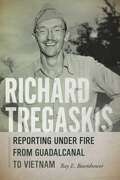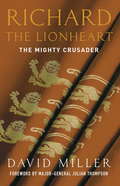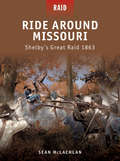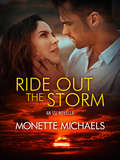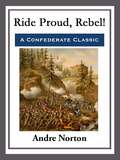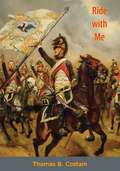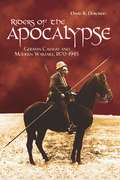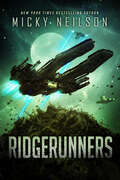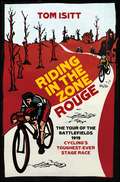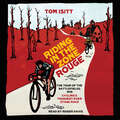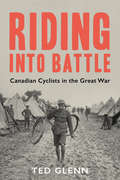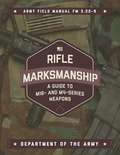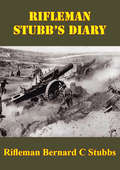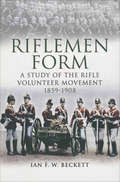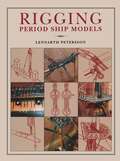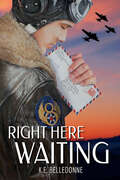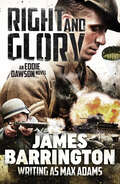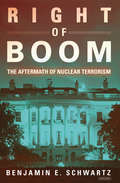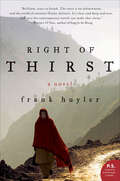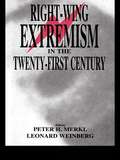- Table View
- List View
Richard S. Ewell
by Donald C. PfanzGeneral Richard Stoddert Ewell holds a unique place in the history of the Army of Northern Virginia. For four months Ewell was Stonewall Jackson's most trusted subordinate; when Jackson died, Ewell took command of the Second Corps, leading it at Gettysburg, the Wilderness, and Spotsylvania Court House. In this biography, Donald Pfanz presents the most detailed portrait yet of the man sometimes referred to as Stonewall Jackson's right arm. Drawing on a rich array of previously untapped original source materials, Pfanz concludes that Ewell was a highly competent general, whose successes on the battlefield far outweighed his failures. But Pfanz's book is more than a military biography. It also examines Ewell's life before and after the Civil War, including his years at West Point, his service in the Mexican War, his experiences as a dragoon officer in Arizona and New Mexico, and his postwar career as a planter in Mississippi and Tennessee. In all, Pfanz offers an exceptionally detailed portrait of one of the South's most important leaders.General Richard Stoddert Ewell holds a unique place in the history of the Army of Northern Virginia. For four months Ewell was Stonewall Jackson's most trusted subordinate; when Jackson died, Ewell took command of the Second Corps, leading it at Gettysburg, the Wilderness Campaign, and Spotsylvania Court House. By the end of the war he was in charge of the defense of Richmond. With this book, Donald Pfanz provides more than just a military biography. He also examines Ewell's life before and after the Civil War, offering an exceptionally detailed portrait of one of the South's most important leaders.-->
Richard Tregaskis: Reporting under Fire from Guadalcanal to Vietnam
by Ray E. BoomhowerIn the late summer of 1942, more than ten thousand members of the First Marine Division held a tenuous toehold on the Pacific island of Guadalcanal. As American marines battled Japanese forces for control of the island, they were joined by war correspondent Richard Tregaskis. Tregaskis was one of only two civilian reporters to land and stay with the marines, and in his notebook he captured the daily and nightly terrors faced by American forces in one of World War II&’s most legendary battles—and it served as the premise for his bestselling book, Guadalcanal Diary.One of the most distinguished combat reporters to cover World War II, Tregaskis later reported on Cold War conflicts in Korea and Vietnam. In 1964 the Overseas Press Club recognized his first-person reporting under hazardous circumstances by awarding him its George Polk Award for his book Vietnam Diary. Boomhower&’s riveting book is the first to tell Tregaskis&’s gripping life story, concentrating on his intrepid reporting experiences during World War II and his fascination with war and its effect on the men who fought it.
Richard the Lionheart: The Mighty Crusader
by David MillerThe greatest general of medieval timesKing Richard I's personal bravery on the battlefield won him the name 'Lionheart' but as David Miller reveals, his battles and campaigns demonstrate a brilliant grasp of strategy and tactics. The 'Lionheart' was no mere medieval 'head banger' but a thoughtful military leader, the only Crusader commander who managed to get an army to Palestine without going bankrupt in the process.
Richard the Lionheart: The Mighty Crusader
by David MillerThe greatest general of medieval timesKing Richard I's personal bravery on the battlefield won him the name 'Lionheart' but as David Miller reveals, his battles and campaigns demonstrate a brilliant grasp of strategy and tactics. The 'Lionheart' was no mere medieval 'head banger' but a thoughtful military leader, the only Crusader commander who managed to get an army to Palestine without going bankrupt in the process.
Ride Around Missouri & Shelby's Great Raid 1863
by Sean Mclachlan Johnny ShumateIn July 1863, with the Confederacy still reeling from the defeats at Vicksburg and Gettysburg, Union forces pushed deep into Arkansas, capturing the capital of Little Rock. In response, Colonel Joseph O. Shelby launched a daring raid to disrupt the advance. Taking 600 men and a section of light artillery, he slipped behind enemy lines. Moving by night to confuse the enemy, Shelby captured a series of small outposts, collecting weapons and recruits as he went. As they continued their ride, the rebels tore up railroad tracks, burned bridges, and cut telegraph lines. Despite these successes, the Union troops slowly closed in on the raiders. Shelby fought a series of bitter skirmishes, until he found himself surrounded. Unwilling to surrender, Shelby led a charge through the Federal lines, bursting out into the open country and onto the road back to the Confederacy. While the results of this raid are still debated by historians, no one has ever doubted its boldness, and west of the Mississippi it became common to boast, "You've heard of Jeb Stuart's ride around McClellan? Hell, brother, Jo Shelby rode around MISSOURI!"
Ride Out the Storm (Security Specialists International)
by Monette Michaels“The tough, protective heroes you’ve been waiting for. Fans of Maya Banks’ KGI, Susan Stoker, and Lexi Blake will love Monette Michaels’ Security Specialists International series.” —Cherise Sinclair, NY Times and USA Today Bestselling Author. They escaped the cartel in Mexico.Three months after a dangerous and chaotic flight to freedom, Dr. Anton Vasilov and his new wife Lucia have settled into the small-town life of Osprey's Point. Courtesy of SSI, Anton now runs the town's sole medical practice. Trained chef Lucia is cooking part-time at Earl's Diner.They believe they've finally found a safe haven from Lucia's vicious uncle and his cartel henchmen.Gaining the town's trust might take longer.Although the isolated lakefront community welcomes the new chef, Anton isn't as lucky. The year-round residents, mostly hardened military vets, have a harder time accepting him. Anton is determined to gain their trust and be part of the town, because he and Lucia have a baby on the way.However, their safe haven may not be safe, after all.Worry creeps into their newfound happiness when a stranger comes to town. Has the cartel found them? As the SSI operatives and vets consider tactics, Anton formulates his own plan. Because the ex-Russian special forces soldier will do whatever it takes to protect his wife and unborn child.Fighting for their lives and their home, Anton and Lucia must ride out the storm one more time.“Ms. Michaels' writing is tight, the dialogue is witty and it deserves to be on your "MUST READ" list.” –John Matteson, Goodreads.Read all of Monette Michaels' series: Security Specialists International1 - Eye of the Storm1.5 - Stormy Weather Baby2 - Cold Day in Hell2.5 - Storm Front3 - Weather the Storm4 - Storm Warning 4.5 - Hot as Hell5 - An Ill Wind6 - FirestormThe Prime Chronicles1 - Prime Obsession2 - Prime Selection3 - Prime Imperative3.5 - Prime Claiming4 - Prime TargetThe Gooden and Knight Mysteries 1 - A Virtuous Vampire2 - The Deadly Séance
Ride Proud, Rebel!
by Andre NortonA dramatic portrayal of the last year of the Confederacy, when brave men met defeat with honor.
Ride with Me
by Thomas B. CostainIN 1805 Francis Ellery, young publisher of the London Tablet, was convinced that Napoleon would cross the Channel unless something was done to prevent it. He promptly launched his paper on a campaign to arouse England. The immediate antagonism of his Parliament seeking brother Caradoc, the near collapse of his paper, and a short prison term were the results. On top of all this Francis fell in love with a vivacious French refugee, Gabrielle de Salle. Off to Portugal as the first war correspondent, he returned wounded to find Gabrielle engaged to Caradoc. It soon developed that Gabrielle’s brother was a spy for Napoleon. Francis arranged for her escape to France, where she became an ardent Bonapartist and married the stupid Comte de Vitrelle.At this point a less determined lover than Francis Ellery would have given up. Ahead of him lay long years of waiting, with only the knowledge that Gabrielle liked and trusted him. It was only during Napoleon’s retreat from Russia that a brief meeting with Francis made her realize that her patient Englishman was as dear to her as her Emperor.Primarily the story of Francis and Gabrielle, it is also the story of the leaders of a great period in history; tense, and packed with thousands of details on prisons, hospitals, gambling, a London newspaper in 1805; details which catch the breath of life link the emotions of that period to our own.
Riders of the Apocalypse
by David R. DorondoDespite the enduring popular image of the blitzkrieg of World War II, the German Army always depended on horses. It could not have waged war without them. While the Army's reliance on draft horses to pull artillery, supply wagons, and field kitchens is now generally acknowledged, D. R. Dorondo's Riders of the Apocalypse examines the history of the German cavalry, a combat arm that not only survived World War I but also rode to war again in 1939. Though concentrating on the period between 1939 and 1945, the book places that history firmly within the larger context of the mounted arm's development from the Franco-Prussian War of 1870 to the Third Reich's surrender.Driven by both internal and external constraints to retain mounted forces after 1918, the German Army effectively did nothing to reduce, much less eliminate, the preponderance of non-mechanized formations during its breakneck expansion under the Nazis after 1933. Instead, politicized command decisions, technical insufficiency, industrial bottlenecks, and, finally, wartime attrition meant that Army leaders were compelled to rely on a steadily growing number of combat horsemen throughout World War II. These horsemen were best represented by the 1st Cavalry Brigade (later Division) which saw combat in Poland, the Netherlands, France, Russia, and Hungary. Their service, however, came to be cruelly dishonored by the horsemen of the 8th Waffen-SS Cavalry Division, a unit whose troopers spent more time killing civilians than fighting enemy soldiers.Throughout the story of these formations, and drawing extensively on both primary and secondary sources, Dorondo shows how the cavalry's tradition carried on in a German and European world undergoing rapid military industrialization after the mid-nineteenth century. And though Riders of the Apocalypse focuses on the German element of this tradition, it also notes other countries' continuing (and, in the case of Russia, much more extensive) use of combat horsemen after 1900. However, precisely because the Nazi regime devoted so much effort to portray Germany's armed forces as fully modern and mechanized, the combat effectiveness of so many German horsemen on the battlefields of Europe until 1945 remains a story that deserves to be more widely known. Dorondo's work does much to tell that story.
Ridgerunners (Ridgerunners)
by Micky NeilsonFrom The New York Times Bestselling author from the World of Warcraft universe, comes this engaging science fiction, military series."A fun, fast adventure for space opera fans.&” — Publishers WeeklyAladhra doesn&’t run from anyone, not even the Collective.On the outskirts of earth&’s solar system, rule number one is to stay out of the Collective&’s way. They are ruthless, and powerful, and rule with an iron fist. They have no patience for Ridgerunners—the pirates and smugglers who thrive on the edges of their reach.But Aladhra&’s crew, the Pack, would rather run straight towards the Collective, guns blazing. Even wildly outmanned and outclassed, they would sacrifice everything for one shot at toppling the corrupt regime.When Aladhra and the Pack get their hands on next-generation technology, they set out to end the Collective once and for all. But the Collective knows they&’re coming. With a bounty on their heads that no Ridgerunner could resist, the Pack is surrounded by enemies, including former allies.What chance does one ship have against an entire solar system?"Fast-paced and clever, with plenty of twists and turns!" - Christie Golden, NYT Bestselling Author"A motley crew of interstellar pirates go up against . . . well, the rest of the known universe. This is adventure and blasters and an underdog story told at light speed––Micky Neilson's handle on sharp dialogue and action kept me laughing, shouting, and cussing at the Law of Thermodynamics." - Cameron Dayton, bestselling author of Etherwalker and creative director for Call of Duty.
Riding in the Zone Rouge: The Tour of the Battlefields 1919 Cyclings Toughest-Ever Stage Race
by Tom IsittThe Circuit des Champs de Bataille (the Tour of the Battlefields) was held in 1919, less than six months after the end of the First World War. It covered 2,000 kilometres and was raced in appalling conditions across the battlefields of the Western Front, otherwise known as the Zone Rouge. The race was so tough that only 21 riders finished, and it was never staged again.With one of the most demanding routes ever to feature in a bicycle race, and plagued by appalling weather conditions, the Circuit des Champs de Bataille was beyond gruelling, but today its extraordinary story is largely forgotten. Many of the riders came to the event straight from the army and had to ride 18-hour stages through sleet and snow across the battlefields on which they had fought, and lost friends and family, only a few months before. But in addition to the hellish conditions there were moments of high comedy, even farce.The rediscovered story of the Circuit des Champs de Bataille is an epic tale of human endurance, suffering and triumph over extreme adversity.
Riding in the Zone Rouge: The Tour of the Battlefields 1919 – Cycling's Toughest-Ever Stage Race
by Tom Isitt'An evocatively thoughtful wider history of the race, the war and the peace' GUARDIAN'Occasionally funny and regularly poignant, brilliantly focused in its research . . . His drive, wit and curiosity inform Zone Rouge . . . gently profound and genuinely moving' HERALDThe Circuit des Champs de Bataille (the Tour of the Battlefields) was held in 1919, less than six months after the end of the First World War. It covered 2,000 kilometres and was raced in appalling conditions across the battlefields of the Western Front, otherwise known as the Zone Rouge. The race was so tough that only 21 riders finished, and it was never staged again.With one of the most demanding routes ever to feature in a bicycle race, and plagued by appalling weather conditions, the Circuit des Champs de Bataille was beyond gruelling, but today its extraordinary story is largely forgotten. Many of the riders came to the event straight from the army and had to ride 18-hour stages through sleet and snow across the battlefields on which they had fought, and lost friends and family, only a few months before. But in addition to the hellish conditions there were moments of high comedy, even farce.The rediscovered story of the Circuit des Champs de Bataille is an epic tale of human endurance, suffering and triumph over extreme adversity.
Riding in the Zone Rouge: The Tour of the Battlefields 1919 – Cycling's Toughest-Ever Stage Race
by Tom Isitt'An evocatively thoughtful wider history of the race, the war and the peace' GUARDIAN'Occasionally funny and regularly poignant, brilliantly focused in its research . . . His drive, wit and curiosity inform Zone Rouge . . . gently profound and genuinely moving' HERALDThe Circuit des Champs de Bataille (the Tour of the Battlefields) was held in 1919, less than six months after the end of the First World War. It covered 2,000 kilometres and was raced in appalling conditions across the battlefields of the Western Front, otherwise known as the Zone Rouge. The race was so tough that only 21 riders finished, and it was never staged again.With one of the most demanding routes ever to feature in a bicycle race, and plagued by appalling weather conditions, the Circuit des Champs de Bataille was beyond gruelling, but today its extraordinary story is largely forgotten. Many of the riders came to the event straight from the army and had to ride 18-hour stages through sleet and snow across the battlefields on which they had fought, and lost friends and family, only a few months before. But in addition to the hellish conditions there were moments of high comedy, even farce.The rediscovered story of the Circuit des Champs de Bataille is an epic tale of human endurance, suffering and triumph over extreme adversity.
Riding into Battle: Canadian Cyclists in the Great War
by Ted GlennThe untold story of how Canadian Cyclists came into their own during the Hundred Days campaign of the Great War. Canada’s Cyclists spent most of the First World War digging trenches, patrolling roads, and delivering dispatches. But during the Hundred Days campaign at the end of the Great War, Canada’s cycling troops finally came into their own. At Amiens, Cambrai, and especially the Pursuit from the Sensée, the Cyclists made pioneering contributions to the development of the Canadian Corps’s combined arms strategy and mobile warfare doctrine, all the while exhibiting the consummate professionalism the Corps became renowned for.
Rifle Marksmanship: A Guide to M16- and M4-Series Weapons
by Army, Department of theRifle Marksmanship is the newly revised, official guide to planning and executing training on the M16-series rifles (M16A1, M16A2, M16A3, and M16A4) and M4 carbine. This handbook is developed by the US Army for commanders, leaders, and instructors to help create training programs and materials for soldiers to complete the United States Army rifle marksmanship program. It offers a comprehensive guide to the specifics and capabilities of each weapon and an introduction to the fundamentals of marksmanship, followed by complete guidance through each of the five stages of rifle marksmanship training. Topics covered include: Weapon Characteristics, Accessories, and Ammunition Range Safety and Risk Management Preliminary Marksmanship and Mechanical Training Advanced Optics, Lasers, and Iron Sights 10-Meter Target Offsets and 25-Meter Zero Offsets Training Aids, Devices, and Scorecards Replete with information and training materials for learners and instructors, this handbook provides the guidance for all shooters, whether in combat or in hunting and recreation, to operate their rifles with deadly proficiency.
Rifleman Stubb’s Diary
by Rifleman Bernard Castle StubbsThe short, but poignant and action-filled diary of a South African fighting in the British Army in 1915 during the First World War.Bernard Castle Stubbs was a bright and well-liked employee of the Union-Castle Line, enjoying his peacetime career at their head offices at Fenchurch Street in London. Although a South African by birth, he had spent most of his schooldays in England, he joined the 9th Battalion London Regiment, better known as Queen Victoria's Rifles, when the First World War broke out. He was involved in the heavy brutal fighting around Hill 60 in the Ypres Salient on the night of 20-21 April 1915 during which Lieutenant Geoffrey Woolley of the Rifles won the Victoria Cross for conspicuous bravery. The Author's luck would not hold long under the constant bloodshed of the frontlines and on the 22nd June 1915 he was mortally wounded by German shellfire.
Riflemen Form: A Study of the Rifle Volunteer Movement 1859–1908
by Ian F. BeckettLt.-Gen. Sir Garnet Wolseley commented that history would record the formation of the Volunteers Movement as one of the most remarkable events in the century. In this study of the Rifle Volunteer Movement, the author Ian Beckett has drawn from a wide range of primary source material such as official, regimental, local and private repositories. He has been able to put into perspective the Movement within the structure of the Victorian and Edwardian social, political and military affairs from its formation in 1859 to its absorption in the Territorial Force in 1908.
Rigging Period Ships Models: A Step-by-Step Guide to the Intricacies of Square-Rig
by Lennarth PeterssonThe rigging of period ship models is the most complex task which any modeller has to take on, for an eighteenth-century man-of-war boasted mile on mile of rigging, more than 1,000 blocks, and acres of canvas. To reduce this in scale, and yet retain an accurate representation, is an awesome undertaking. This now classic work untangles the complex web, and, using some 400 drawings, the author shows clearly how each separate item of rigging is fitted to the masts, yards and sails. Each drawing deals with only one particular item so that it can be seen clearly in isolation. The lead of a particular halliard, the arrangement of a bracing line, these and every other detail is depicted with startling clarity. Based on the authors research of numerous eighteenth-century models, each one with its contemporary rigging still extant, the information is both meticulous and accurate.The remarkable visual immediacy and clarity of this work makes it truly unique and no modeller of period ships can afford to be without it at his side. In addition, the book is a must-have practical reference work for all those involved in the rigging and repair of historic ships.
Right Here Waiting
by K. E. Belledonnein 1942, Ben Williams had it all--a fulfilling job, adoring friends and the love of his life, Pete Montgomery. But World War ii looms. When Pete follows his conscience and joins the Army Air Forces as a bomber pilot, Ben must find the strength to stay behind without the love of his life, the dedication to stay true and the courage he never knew hed need to discover his own place in the war effort. Good friends help keep him afloat, until a chance meeting on the homefront brings him an unexpected ally--one who will accompany him from the stages of New York City to the hell of the European warfront in search of his love.
Right and Glory (An Eddie Dawson Novel)
by James BarringtonEddie Dawson returns in a combustible World War II thriller of bravery and close combat in the fight against Hitler from the author of To Do or Die. Eddie Dawson and Major Sykes are sent to the impregnable Eben Emael in Belgium, the strongest fort in the world. Once there, they witness a group of German soldiers landing on the roof in gliders. This main attack lasts twenty minutes, leaving Eben Emael crippled. But Dawson is disturbed—he has seen the Germans do the impossible: blasting holes through solid twelve-inch steel armor using some kind of new demolition charge. This secret weapon could change everything. They simply must get one. But how? And can they make it through enemy lines, out all the way to Dunkirk and to safety? The second explosive tale of Eddie Dawson&’s derring-do in the Second World War, perfect for fans of Iain Gale and Alistair MacLean. Praise for To Do or Die &“[An] absorbing story . . . [James Barrington] knows his stuff.&” —The Historical Novels Review
Right of Boom: The Aftermath of Nuclear Terrorism
by Benjamin E. Schwartz&“[A] seasoned national security professional and gifted writer&” offers an in-depth analysis of what might happen after a nuclear attack on US soil (Matthew Kroenig, author of Exporting the Bomb). In the parlance of disaster preparedness, &“right of boom&” refers to the terrifying moments after a crisis hits. In Right of Boom, national security specialist Benjamin Schwartz examines what could happen after a nuclear explosion takes place in the United States—the event that many experts have acknowledged as the greatest single national security threat we face. While many assume such an attack would automatically trigger a globally devastating exchange of nuclear attacks, Schwartz demonstrates that the realities are far more nuanced and complex. Hypothesizing an explosion in downtown Washington, DC, Schwartz maps out the likely ramifications while going deep into history to explore the limited range of options available to a commander in chief. Drawing from his experience as an analyst at the Departments of Defense, State, and Energy, Schwartz offers a fully panoramic view of a terrifyingly real possibility. &“Should be required reading.&” —The Washington Free Beacon
Right of Thirst: A Novel (P. S. Ser.)
by Frank HuylerA grieving doctor seeks redemption as a foreign relief worker—only to be caught in the fog of war—in this “vivid and compassionate” novel (Kirkus).Shattered by his wife’s death, and by his own role in it, successful cardiologist Charles Anderson volunteers to assist with earthquake relief in an impoverished Islamic country in a constant state of conflict with its neighbor. But when the refugees he’s come to help do not appear and artillery begins to fall in the distance along the border, the story takes an unexpected turn.This haunting, resonant tour de force about one man’s desire to live a moral life offers a moving exploration of the tensions between poverty and wealth, the ethics of intervention, the deep cultural differences that divide the world, and the essential human similarities that unite it.
Right-wing Extremism in Western Europe
by Klaus von BeymeFirst Published in 1988. Routledge is an imprint of Taylor & Francis, an informa company.
Right-wing Extremism in the Twenty-first Century
by Peter H. Merkl Leonard WeinbergRevising the 1997 first edition, this study covers events that occurred in Oldham and Bradford after the year 2000. The rise of right-wing extremist groups is put under scrutiny in a number of states including Britain, Germany, Austria, Russia and France.
Righteous Gentile: The Story of Raoul Wallenberg, Missing Hero of the Holocaust
by John BiermanWallenberg's heroism, and the acts that stirred him to action, are clearly dramatic, yet the man remains distant and slightly detached in this account by Bierman - like the Pimpernel, Raoul is an elusive figure, part legend and part controversy.

